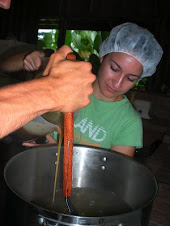I had such an incredible day today! I spent an afternoon with Ana and Neni, two of our lovely cooks, making cookies and jam! We made about 250 ginger cookies, 40 oatmeal raisin cookies, and jarred 100 jars of starfruit jam and 30 jars of guava jam. The amount of food produced in a small kitchen with only four stovetops and one oven is incredible. And the combination of the simmering vats of jams and constant production of cookies made the kitchen smell heavenly! I wanted to bottle that smell and remember it forever. After hours of hard work, and also to ensure the quality of our labors, Ana and I enjoyed chilled glasses of fresh goat milk and cookies—delicious!
Earlier in the week Rafa, our charming and super knowledgeable ethnobotanist, came out to visit. I accompanied him and Steven around the Sacred Seeds Garden as we talked about various plants. It was such a pleasure to follow Rafa into the garden and listen to him explain a little bit about each of the plants. He pointed out a carob tree, sangre de drago, chirca, and spoke a little bit about each of their properties. It was very interesting and right up my alley—I love learning about plants. Although he only spoke Spanish, I seemed to understand everything he was saying, though not without some help from Steven. Rafa pointed out the relative toxicities of some plants and their various uses in different cultures. He explained how some plants are deemed completely toxic simply on the account of one of the many compounds they possess, and as a result are no longer investigated for their medicinal worth. This is unfortunate because some plants, like pharmaceuticals, are toxic in high doses, but at low doses, their toxicity is minimal and their medicinal values are notable. He also noted how plants are not often enough analyzed in their whole forms, but are instead investigated only in isolated compounds. Whole forms of a plant can often provide maximum medicinal value through a combination of complemented compounds that isolated compounds cannot. Fascinating. Seems common sense. Rafa is trying to put together a second volume booklet of information about selected plants in the garden. Hopefully I’ll get to help out with some research for it.
The night before Rafa left, we had a great dinner, which I complemented with a glass of wine at Rafa and his Spanish friend’s insistence. They kept persisting that it would improve my Spanish speaking abilities, though I’m not quite sure it did. All in all, it was a great week.
ethnobotany
Saturday, September 20, 2008
Subscribe to:
Post Comments (Atom)







No comments:
Post a Comment